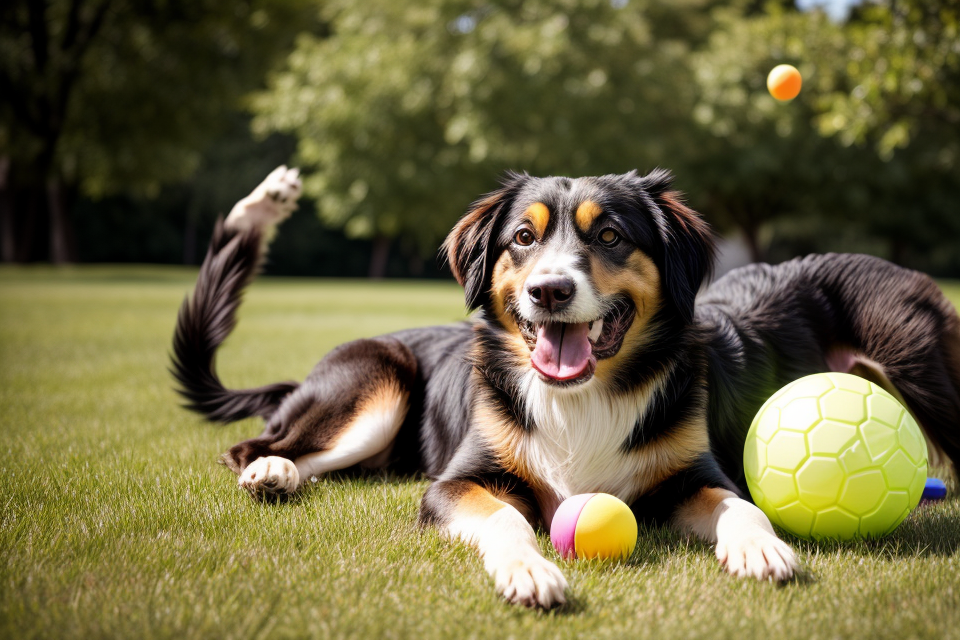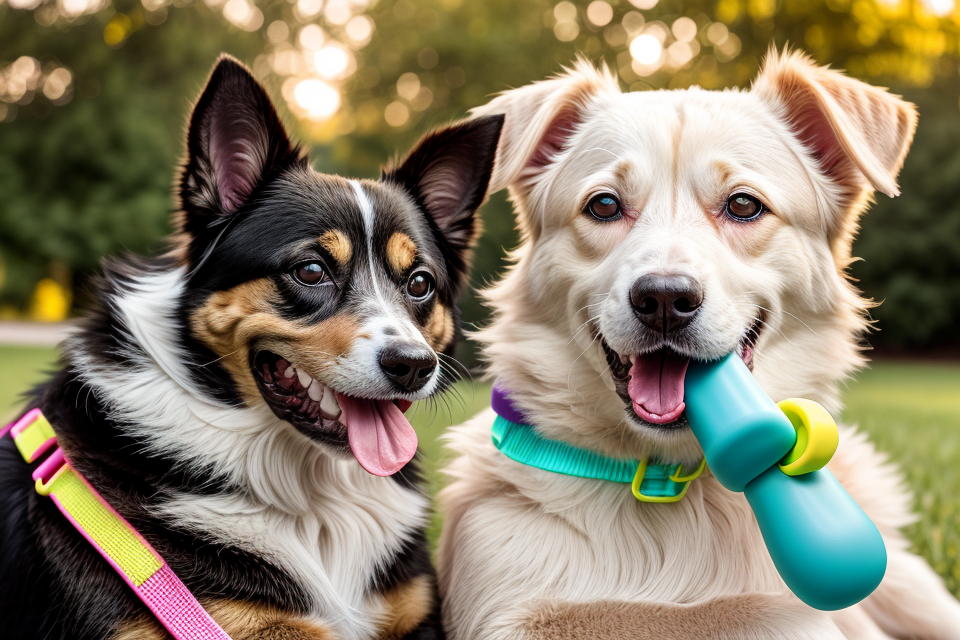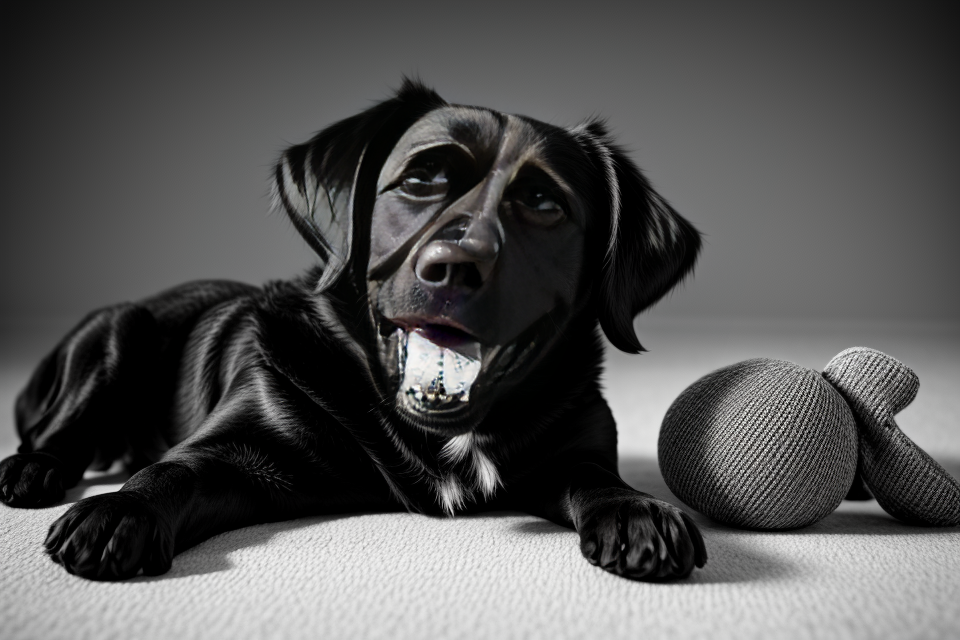Is your furry friend more interested in chewing on your shoes than chew toys? If so, you’re not alone. Many dogs tend to prefer other items over their designated chew toys. But, as a responsible pet owner, it’s important to encourage your dog to chew on chew toys instead of other household items. In this article, we’ll provide you with some tips and tricks on how to get your dog to chew on chew toys, while also discussing the benefits of doing so. So, let’s dive in and explore the world of chew toys with your furry friend!
Understanding Your Dog’s Chewing Habits
Why Do Dogs Chew?
Dogs chew for a variety of reasons, some of which are deeply ingrained in their nature as animals. Here are some of the most common reasons why dogs chew:
- A natural behavior: Dogs have a natural instinct to chew, just like how humans have the instinct to chew their food. This is because chewing helps to break down food and facilitate digestion. However, this instinct is not limited to food alone, and dogs may chew on objects other than food as well.
- Teeth cleaning and jaw exercise: Chewing helps to clean a dog’s teeth and massage their gums, which can help to prevent dental problems such as plaque buildup and gum disease. Chewing also helps to strengthen a dog’s jaw muscles, which can help to keep their teeth and gums healthy.
- Stress relief and boredom: Dogs may chew when they are stressed or bored. Chewing can provide a sense of comfort and security, and it can also help to alleviate anxiety and stress. However, it is important to note that chewing can become a problem if a dog is consistently chewing on objects that they should not be chewing on.
Types of Chewing in Dogs
Chewing is a natural behavior for dogs, and it serves various purposes such as providing exercise for their jaws, relieving stress, and satisfying their instinctual desire to chew. Understanding the different types of chewing in dogs can help you better address and manage this behavior. Here are the three main types of chewing in dogs:
Aggressive Chewing
Aggressive chewing is characterized by the dog using their teeth to break objects apart, such as furniture, shoes, or toys. This type of chewing can be destructive and is often associated with stress, anxiety, or boredom. Aggressive chewing can also be a sign of underlying medical issues, such as dental problems or pain.
To address aggressive chewing, it’s essential to provide your dog with appropriate chew toys made from durable materials, rotate toys frequently to keep them interesting, and offer plenty of exercise and mental stimulation.
Destructive Chewing
Destructive chewing is similar to aggressive chewing, but it’s more severe. In addition to breaking objects apart, the dog may also consume the pieces, which can cause blockages or other health issues. Destructive chewing can be a sign of separation anxiety or boredom and may require professional intervention.
To prevent destructive chewing, provide your dog with plenty of appropriate chew toys, rotate toys frequently, and create a schedule that provides structure and routine.
Normal Chewing
Normal chewing is a natural behavior for dogs and is usually harmless. It’s how puppies explore their environment and how adult dogs keep their teeth and jaws strong. Normal chewing involves chewing on soft or hard objects, such as toys, bones, or treats.
To encourage normal chewing, provide your dog with a variety of appropriate chew toys made from different materials, rotate toys frequently, and supervise your dog when chewing to ensure they’re not consuming harmful objects.
Choosing the Right Chew Toys for Your Dog
Factors to Consider
When selecting chew toys for your dog, it is important to consider several factors to ensure that the toys are safe, appropriate, and enjoyable for your furry friend. Here are some key factors to keep in mind:
Size and Shape
The size and shape of the chew toy should be appropriate for your dog’s mouth and jaw size. Too small or too large a toy can cause problems, such as choking or teeth or jaw injuries. Additionally, consider the shape of the toy. Some dogs prefer flat or curved toys, while others may prefer toys with more complex shapes.
Material and Texture
The material and texture of the chew toy can affect how long the toy lasts and how much your dog enjoys chewing on it. Some dogs prefer toys made from rubber, while others prefer toys made from rope or nylon. Consider your dog’s preferences and the texture of the toy. Some dogs prefer toys with a lot of texture, while others prefer toys with a smoother surface.
Durability and Safety
The durability and safety of the chew toy are also important factors to consider. Look for toys that are made from durable materials that can withstand your dog’s chewing. Additionally, make sure the toy is safe for your dog. Avoid toys with small parts that can be swallowed or toys that can break into small pieces and cause choking.
Overall, by considering these factors, you can choose the right chew toys for your dog and encourage them to chew on them instead of other items in your home.
Types of Chew Toys
There are various types of chew toys available in the market that can keep your dog engaged and satisfied. Some of the most popular types of chew toys include:
- Rubber toys: Rubber toys are made from durable rubber material that can withstand heavy chewing. They come in various shapes, sizes, and colors, and are perfect for dogs that love to chew.
- Rope toys: Rope toys are made from rope or rope-like materials that are designed to be chewed. They are great for dogs that love to chew on rope or leather. Rope toys can be found in various sizes and shapes, and some even have squeakers inside.
- Plush toys: Plush toys are made from soft, plush material that is perfect for dogs that love to cuddle. They come in various shapes, sizes, and colors, and some even have squeakers inside.
- Interactive toys: Interactive toys are designed to keep your dog engaged and mentally stimulated. They come in various shapes, sizes, and materials, and some even have hidden treats inside. Examples of interactive toys include puzzle toys, hide-and-seek toys, and treat-dispensing toys.
It is important to choose the right type of chew toy for your dog based on their size, chewing habits, and preferences. Some dogs may prefer rubber toys, while others may prefer rope or plush toys. Interactive toys are great for mentally stimulating your dog and keeping them engaged for longer periods of time.
When choosing chew toys for your dog, it is important to consider their size and strength. Some chew toys may be too small or too soft for larger dogs, while others may be too difficult for smaller dogs to chew on. It is also important to monitor your dog while they are chewing on a chew toy to ensure that they are not swallowing large pieces or shards.
Overall, there are many different types of chew toys available for dogs, and choosing the right one can help keep them engaged, satisfied, and mentally stimulated.
Introducing Chew Toys to Your Dog
Gradual Introduction
- Start with small toys: When introducing chew toys to your dog, it’s important to start with small toys that are easy for them to handle. This will help prevent choking and ensure that your dog gets used to the feel and taste of the toy.
- Monitor your dog’s reaction: As you introduce the chew toy to your dog, it’s important to monitor their reaction to ensure that they are comfortable with the toy. If your dog seems hesitant or uninterested in the toy, try switching to a different type of toy or waiting a few days before trying again.
- Increase size and variety gradually: Once your dog is comfortable with small chew toys, you can gradually increase the size and variety of the toys you offer. This will help keep your dog engaged and interested in chewing on their toys. You can also try adding different textures and flavors to the toys to keep things interesting for your dog.
Positive Reinforcement
Reward your dog with treats and praise
One of the most effective ways to encourage your dog to chew on chew toys is by rewarding them with treats and praise. This positive reinforcement technique works by reinforcing good behavior, making it more likely that your dog will repeat the behavior in the future. When your dog chews on a chew toy, give them a treat and plenty of praise to reinforce the behavior. This will let your dog know that chewing on chew toys is a desirable behavior that will earn them rewards.
Use high-value rewards to encourage chewing
Another effective strategy for encouraging your dog to chew on chew toys is by using high-value rewards. High-value rewards are treats or toys that your dog really loves, such as pieces of chicken, steak, or their favorite toy. By using these high-value rewards, you can make chewing on chew toys more appealing to your dog. This will increase the likelihood that your dog will choose to chew on chew toys instead of other objects in their environment.
Be consistent and patient
Finally, it’s important to be consistent and patient when introducing chew toys to your dog. Consistency is key, as it will help your dog understand what is expected of them. Be sure to offer chew toys at the same time each day, and always reward your dog for chewing on them. Patience is also important, as it may take some time for your dog to become interested in chew toys. Don’t get discouraged if your dog doesn’t seem interested at first – with time and patience, they will likely come to enjoy chewing on chew toys.
Encouraging Chewing Behavior
Provide Multiple Toys
Chewing is a natural behavior for dogs, and providing them with a variety of chew toys can help satisfy this instinct while also keeping them entertained and mentally stimulated. Here are some tips for providing multiple chew toys to your dog:
Rotate Toys Frequently
One of the best ways to keep your dog interested in their chew toys is to rotate them frequently. This means changing out the toys in your dog’s play area or crate on a regular basis, so they always have something new to explore. Rotating toys also helps prevent boredom and helps prevent your dog from becoming too attached to any one toy.
Keep Toys in Different Locations
In addition to rotating toys frequently, it’s also a good idea to keep them in different locations around your home. This can help encourage your dog to explore different areas of the house and can also help prevent them from becoming too attached to any one location.
Offer a Variety of Textures and Materials
Providing your dog with a variety of textures and materials to chew on can help keep them engaged and satisfied. This can include rubber toys, rope toys, nylon toys, and more. It’s also a good idea to offer a range of textures, such as soft and hard, to keep your dog interested and engaged.
By following these tips, you can help encourage your dog to chew on chew toys and keep them entertained and mentally stimulated.
Create a Chewing Schedule
Benefits of a Chewing Schedule
- Encourages proper oral hygiene
- Provides mental stimulation
- Reduces destructive chewing behaviors
- Strengthens the bond between dog and owner
How to Create a Chewing Schedule
- Set aside specific times for chewing: Determine when your dog will chew on their toys, such as after meals or during designated playtime.
- Make chewing a part of daily routine: Incorporate chewing into your dog’s daily routine, so it becomes a familiar and anticipated activity.
- Use chewing as a reward for good behavior: Reward your dog with chew time for exhibiting desirable behaviors, such as being patient or following commands.
Tips for Implementing a Chewing Schedule
- Start slowly: Gradually increase the amount of time your dog spends chewing and the frequency of chewing sessions.
- Supervise: Monitor your dog during chew time to ensure they are chewing their toys and not other objects.
- Rotate toys: Introduce new chew toys regularly to keep things interesting and prevent boredom.
- Be patient: It may take some time for your dog to become accustomed to chewing on toys instead of other objects. Consistency and positive reinforcement are key.
Increase Mental Stimulation
Dogs are intelligent creatures who thrive on mental stimulation. By providing your dog with mental challenges, you can encourage them to chew on chew toys instead of furniture or other items in your home. Here are some tips to increase mental stimulation for your dog:
Provide Mental Challenges
One way to increase mental stimulation for your dog is to provide them with puzzle toys that challenge their problem-solving skills. These toys can be filled with treats or peanut butter, and your dog will have to figure out how to get the reward out. Some popular puzzle toys include the KONG, which has a hollow center that can be filled with treats or peanut butter, and the Outward Hound Hide-A-Squirrel, which has small openings where treats can be hidden.
Another option is to provide your dog with interactive toys that encourage them to use their natural instincts. For example, a stuffed animal toy can be used to simulate a hunt, and your dog will have to use their problem-solving skills to figure out how to get the toy.
Engage in Interactive Play
Interactive play is another great way to increase mental stimulation for your dog. This can include games like hide-and-seek, fetch, and tug-of-war. These games not only provide mental stimulation but also physical exercise, which is important for your dog’s overall health and well-being.
Use Food-Dispensing Toys
Food-dispensing toys are designed to slow down your dog’s eating pace, which can help reduce the risk of gastric dilatation volvulus (bloat), a serious medical condition that can occur in some dogs. These toys dispense kibble or treats when your dog interacts with the toy, encouraging them to chew and play with the toy. Some popular food-dispensing toys include the Nina Ottosson game, which has various challenges that your dog must complete to get the treats, and the Kong Wobbler, which dispenses kibble or treats when your dog knocks it over.
Overall, increasing mental stimulation for your dog is an important part of encouraging them to chew on chew toys. By providing your dog with puzzle toys, interactive play, and food-dispensing toys, you can keep their mind active and engaged, which will help reduce the likelihood of them chewing on inappropriate items in your home.
Preventing Destructive Chewing
Management Techniques
Crate training is a widely recommended method for preventing destructive chewing in dogs. By providing a safe and comfortable environment for your dog when you are not around, you can reduce the likelihood of them chewing on things they shouldn’t.
Supervision is another key management technique for preventing destructive chewing. By keeping a close eye on your dog and providing them with appropriate chew toys, you can redirect their chewing behavior and prevent them from getting into trouble.
Teaching “leave it” and “drop it” commands is also important for preventing destructive chewing. These commands can help you quickly intervene if your dog picks up something they shouldn’t, and can help you establish control over what they chew on. By consistently reinforcing these commands, you can teach your dog to drop items on command and reduce the likelihood of destructive chewing.
Environmental Modifications
One of the most effective ways to prevent destructive chewing in dogs is by making environmental modifications. Here are some tips to help you achieve this:
Provide appropriate chew toys
Providing your dog with appropriate chew toys is the first step in preventing destructive chewing. Choose chew toys that are made from different materials such as rubber, rope, or nylon. Rotate the toys to keep them interesting and to prevent your dog from becoming bored with them. You can also try giving your dog a new chew toy when they exhibit destructive chewing behavior.
Create a safe and interesting environment
Dogs are naturally curious and like to explore their surroundings. Therefore, it is important to create a safe and interesting environment for your dog. This means removing any dangerous objects or items that your dog could potentially chew on. It is also important to provide your dog with a comfortable and safe space to retreat to when they feel overwhelmed or stressed.
Remove access to dangerous objects
Finally, it is important to remove access to dangerous objects that your dog could potentially chew on. This includes household items such as shoes, remote controls, and other items that could cause harm to your dog if ingested. Keep these items out of reach and ensure that your dog does not have access to them.
By implementing these environmental modifications, you can help prevent destructive chewing in your dog and promote healthy chewing behavior.
Seeking Professional Help
- Consult with a veterinarian or behaviorist
- Regular check-ups can help identify any underlying medical issues that may be contributing to your dog’s destructive chewing habits. A veterinarian can also provide guidance on appropriate chew toys and treats that are safe for your dog to consume.
- A behaviorist can help identify any underlying behavioral issues that may be causing your dog to chew on inappropriate objects. They can also provide guidance on training techniques and behavior modification programs that can help address these issues.
- Address underlying medical or behavioral issues
- If your dog has an underlying medical issue, such as dental problems or gastrointestinal issues, it is important to address this issue before attempting to curb destructive chewing behaviors.
- If your dog has an underlying behavioral issue, such as separation anxiety or boredom, it is important to address this issue in order to prevent destructive chewing behaviors from occurring in the first place.
- Consider professional training or behavior modification programs
- If you have tried all of the tips and tricks mentioned in this article and your dog is still exhibiting destructive chewing behaviors, it may be time to consider professional training or behavior modification programs. These programs can provide specialized guidance and support to help address your dog’s behavioral issues and prevent destructive chewing behaviors from occurring in the future.
FAQs
1. Why is it important for my dog to chew on chew toys?
Chewing on chew toys is important for your dog’s mental and physical health. It helps satisfy their natural instinct to chew, and provides them with a safe outlet for their energy and curiosity. Chewing on chew toys can also help reduce the risk of destructive chewing on other household items.
2. What types of chew toys are best for my dog?
There are many types of chew toys available for dogs, including rubber toys, rope toys, nylon toys, and more. It’s important to choose a chew toy that is appropriate for your dog’s size and chewing habits. For example, if your dog has a strong jaw, a rubber toy may be more durable. If your dog is a heavy chewer, a toy made from a harder material like nylon may be a better choice.
3. How do I introduce chew toys to my dog?
To introduce chew toys to your dog, start by giving them the toy when they are relaxed and not expecting it. You can also use the toy as a reward for good behavior or to distract them from unwanted behavior. It’s important to supervise your dog when they are chewing on a toy, and to replace the toy frequently to prevent boredom.
4. How often should I replace my dog’s chew toys?
You should replace your dog’s chew toys frequently to keep them interested and to prevent boredom. Depending on your dog’s chewing habits, you may need to replace the toys every few days to a week. It’s also important to check the toys regularly for any signs of wear and tear, and to discard them if they become damaged or showing signs of wear.
5. Can I give my dog human food as a reward for chewing on chew toys?
While it’s okay to give your dog small pieces of human food as a reward for chewing on chew toys, it’s important to avoid giving them foods that are toxic to dogs. Some human foods, such as chocolate, grapes, and raisins, can be harmful to dogs. It’s best to stick to giving your dog treats that are specifically designed for them, such as dog treats or pieces of cooked chicken or beef.



